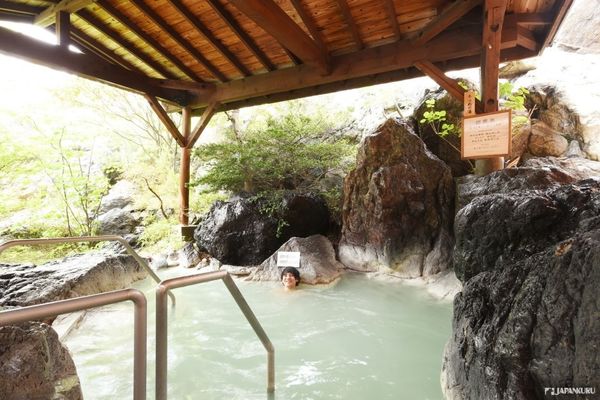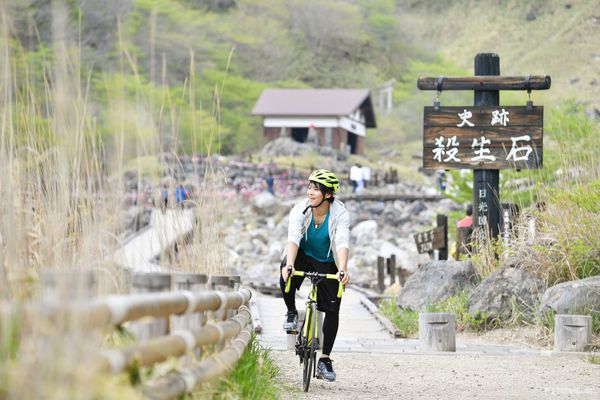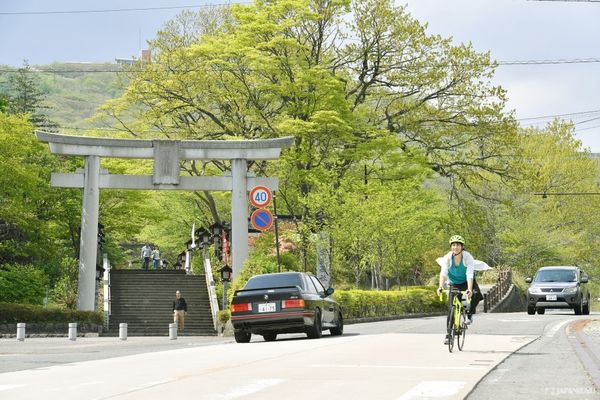CONTENTS
Highly recommended for those who want to spend your holidays in nature!
If you want to get out of the cities and take a healing trip in nature, Nasu in Tochigi Prefecture is a good choice for you. You can ride a bike and enjoy a cycling trip in this beautiful town. Nasu is not just famous for the greenery, there are also many popular hot springs (Onsen) and hotels in this area too!
Hotel Sunvalley Nasu consists of 9 hotels, the Main Building, the Annex, the Queen's Collina, the Forest Villa, the Garden Sweet, the Oriental Garden, the Japanese traditional "tatami" style hotel, the Cottage, and the Owl Forest Cabin.
Do you know that owls symbolize good fortune and luck in Japan?
You can spend your night in Nasu with the symbol of fortune!
The Owl Forest Cabin is highly recommended for families and couples. A cabin can accommodate up to 3 people.
Price: 12,000 to 15,000 yen per person per night (dinner and breakfast included)
Welcome to the Village of Owls!
Simple and Cozy Guest Room
Forest view right outside your room
Air conditioning, heating, and air purifier are prepared in the room too. Of course, a spacious bathroom is included.
A Relaxing Atmosphere
Feel like stepping into a fairy tale story when you enter this cabin room.
See how many owls you can find in your room!
We will leave you to find out other owls in the cabin when you visit there!
What’s special about Hotel Sunvalley Nasu?
Healing Onsen (hot spring) at Hotel Sunvalley Nasu
The hot springs are said that they are good for people who have diabetes and high blood pressure
Tasty Food Waiting For You
You can find Japanese cuisine, Western cuisine, Italian cuisine, and Chinese cuisine at the hotel.
Restaurant – Kogen-No-Table
Spring Food Festival
This Italian restaurant changes their menu from season to season, even the food design is matched with the season! Crabs are provided all year round too!
Freshly Made Tempura
Very tasty prawn tempura, squid tempura, and other vegetables tempura!!
Huge selection of High Quality Dessert
A huge selection of dessert is made by experienced pastry chefs everyday at the hotel.
Cycling Tour in Nasu – Time for Exercise!
Actually many cyclists enjoy biking in nature and that's why you can find many professional bicycle rental shops in Nasu area. If you are not a professional cyclist, don't worry, you can still enjoy cycling in Nasu because bike lanes are built here.
*Nasu Blasen Base(那須ブラーゼンベース)
Adress: Takakuko, Nasu, Tochigi 2888-41
Tel:0287-73-8331
Operating hours:
09:00〜16:00 (November to April)
09:00〜17:00 (May to October)
(Holiday: Every Wednesday and other non-specified days)
Official Website: http://www.nasublasen.com/blasenbase.html
Nasu Blasen Base provides 3 kinds of bikes, Cross Bike (Hybrid bicycle), Road Bike, and Mini Velo.
You can rent the Cross Bike (Hybrid bicycle) or the Road Bike at 1,000 yen for 3 hours or 2,000 yen per day.
Recommended Cycling Course and Spots
The Killing Stone (Sessho-seki)
For those who follow our blog must have seen the story of the Killing Stone in our earlier blog. The Killing Stone can be found in front of the Nasu Yuzen Jinja
Address: 182 Yumoto, Nasu-machi, Nasu, Tochigi
Tel.: 0287-72-6918
Nasu Yuzen Jinja
Nasu Yuzen Jinja is just near the Nasu Information Center
Address: 182 Yumoto, Nasu-machi, Nasu, Tochigi
Tel.: 0287-76-2306
Konbairo No Yu – Foot bath
If you get a bit tired, why don't we take a break and enjoy the foot bath at the "Konbairo No Yu".
Address: 182-14 Yumoto, Nasu-machi, Nasu, Tochigi
The Beautiful Royal Road
A cycling route that the locals highly recommended to take in spring. The name Royal Road is named by the locals too.
Address: Prefecture road no. 21
Ohinata Marche
This market is opened in the morning of the 2nd and 4th Saturday from May to November.
This is definitely a good place for you to visit if you want to experience how the Japanese local people shop and eat.
Address: 5706-41 Takakuko, Nasu-machi, Nasu, Tochigi
Bagel que-veau
15 different kinds of bagels are made everyday at the Bagel que-veau. Which flavor do you like? Original? Nuts? Brownie? Red Beans? Cheese?
Address: 23-4 Takakuko, Nasu-machi, Nasu, Tochigi
Tel.: 0287-62-1484
1) Popular resort with 9 hotels
You can experience different hotels every time you visit there
2) Variety of relaxing hot springs
You can wear your swimming suit to enjoy some of the hot springs
3) Pets are welcome too
You can find a restaurant just for your pets, I bet your pets are happy to travel along with you too!
4) Huge selection of food
Buffet, Japanese cuisine, Western cuisine, Chinese cuisine are served
5) Can be reached by bus
Other than Shinkansen, you can simply take the bus from Ikebukuro to get there
♪Hotel Sunvalley Nasu
Address: 203 Yumoto, Nasu-machi, Nasu-gun, Tochigi, 325-0392
Nasu reservation desk:
+81-287-76-3800 (9:00-20:00)
Tokyo reservation desk:
+81-3-3388-3800 (9:00-18:00 except Sat, Sun and holidays)
Official page: http://www.nasu3800.co.jp
We hope that you enjoy this cycling trip with us this time! Start planning your next trip to Nasu and enjoy the famous hot springs there!
If you want more detailed information about Nasu, please check out our blog:
# Accommodation ♪ A Getaway to Nature – Hotel Sunvalley Nasu
Details
NAME:Hotel Sunvalley Nasu
MAP
203 Yumoto, Nasu-machi, Nasu-gun, Tochigi, 325-0392
CONTACT TEL:0287-76-3800
COMMENT
FEATURED MEDIA
VIEW MOREMAP OF JAPAN
SEARCH BY REGION

LATEST
VIEW MOREEVENT CALENDAR
VIEW MOREMOST POPULAR
 Tokyo Winter Recommendation: Don’t Miss Tokyo Mega Illumination, Japan’s #1 Light Show
Tokyo Winter Recommendation: Don’t Miss Tokyo Mega Illumination, Japan’s #1 Light Show ป้ายยาสินค้าน่าซื้อในร้านขายยาญี่ปุ่น | KOWA ผลิตภัณฑ์เพื่อสุขภาพสำหรับคนยุคใหม่
ป้ายยาสินค้าน่าซื้อในร้านขายยาญี่ปุ่น | KOWA ผลิตภัณฑ์เพื่อสุขภาพสำหรับคนยุคใหม่ Okinawa Family Road Trip: Japanese Glasses Shopping at San-A Urasoe West Coast PARCO CITY, Discount Coupons, & Okinawa Sightseeing with JINS
Okinawa Family Road Trip: Japanese Glasses Shopping at San-A Urasoe West Coast PARCO CITY, Discount Coupons, & Okinawa Sightseeing with JINS


























 >> Find out more at Japankuru.com! (link in bio)
#
>> Find out more at Japankuru.com! (link in bio)
#





 The Robot Restaurant is gone, but the Samurai Restaurant is here to take its place. Check it out, and don't forget your coupon!
The Robot Restaurant is gone, but the Samurai Restaurant is here to take its place. Check it out, and don't forget your coupon!
 신주쿠의 명소 로봇 레스토랑이 사무라이 레스토랑으로 부활! 절찬 쿠폰 발급중
신주쿠의 명소 로봇 레스토랑이 사무라이 레스토랑으로 부활! 절찬 쿠폰 발급중
 18歲以上才能入場的歌舞秀,和你想的不一樣!拿好優惠券去看看~
#tokyo #shinjuku #samurairestaurant #robotrestaurant #tokyotrip #도쿄여행 #신주쿠 #사무라이레스토랑 #이색체험 #할인이벤트 #歌舞伎町 #東京景點 #武士餐廳 #日本表演 #日本文化體驗 #japankuru #japantrip #japantravel #japanlovers #japan_of_insta
18歲以上才能入場的歌舞秀,和你想的不一樣!拿好優惠券去看看~
#tokyo #shinjuku #samurairestaurant #robotrestaurant #tokyotrip #도쿄여행 #신주쿠 #사무라이레스토랑 #이색체험 #할인이벤트 #歌舞伎町 #東京景點 #武士餐廳 #日本表演 #日本文化體驗 #japankuru #japantrip #japantravel #japanlovers #japan_of_insta
 코지마 x 빅 카메라 쿠폰으로 일본 가전 제품 쇼핑하기
#pr #japankuru #japanshopping #kojima #biccamera #japaneseskincare #yaman #dji #osmopocket3 #skincaredevice #日本購物 #美容儀 #相機 #雅萌 #日本家電 #일본여행 #면세 #여행꿀팁 #일본쇼핑리스트 #쿠폰 #일본쇼핑 #일본브랜드 #할인 #코지마 #빅카메라 #japankurucoupon
코지마 x 빅 카메라 쿠폰으로 일본 가전 제품 쇼핑하기
#pr #japankuru #japanshopping #kojima #biccamera #japaneseskincare #yaman #dji #osmopocket3 #skincaredevice #日本購物 #美容儀 #相機 #雅萌 #日本家電 #일본여행 #면세 #여행꿀팁 #일본쇼핑리스트 #쿠폰 #일본쇼핑 #일본브랜드 #할인 #코지마 #빅카메라 #japankurucoupon






























 Oita Hello Kitty Airport
Oita Hello Kitty Airport  Lands April 13th
Lands April 13th























